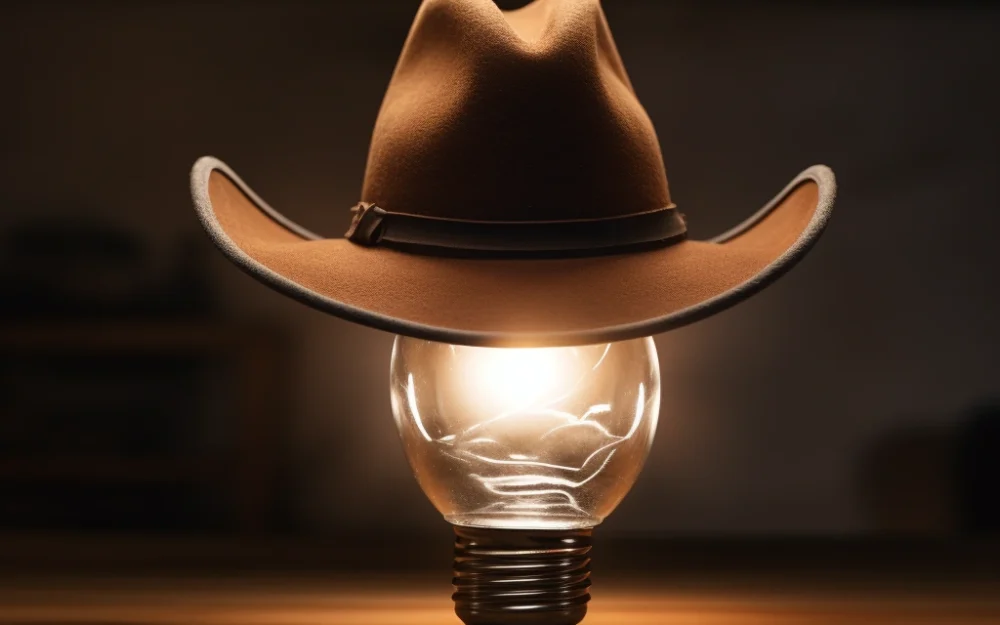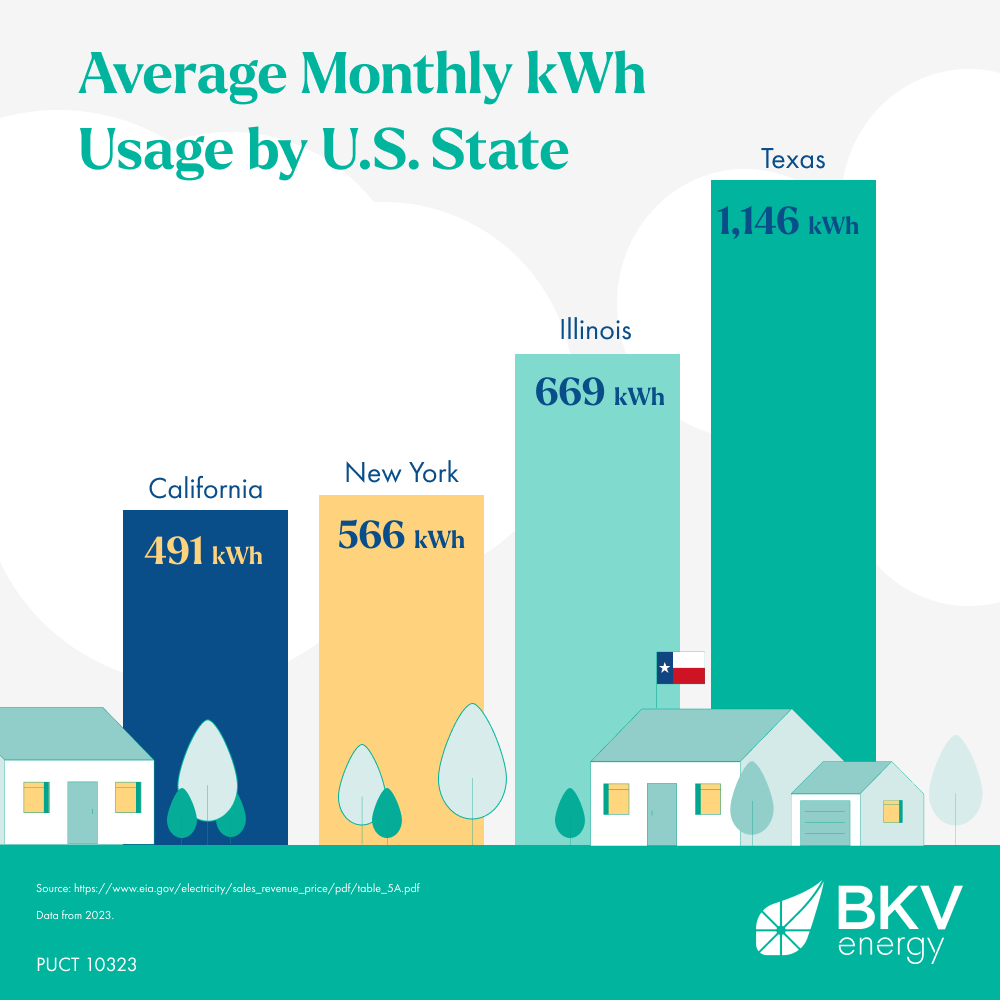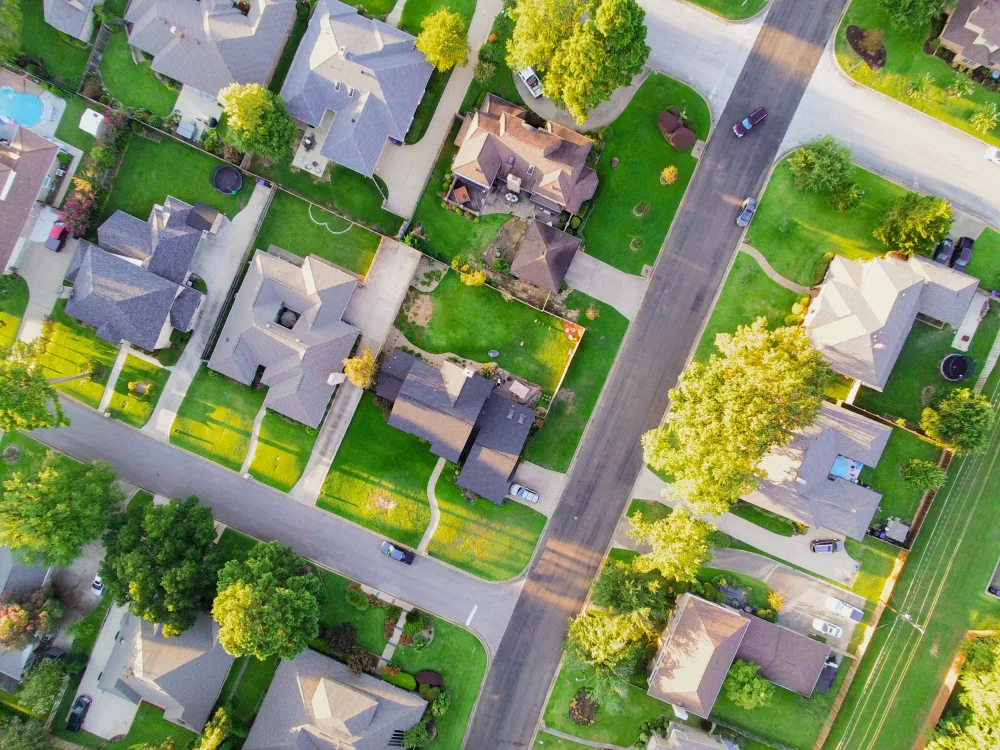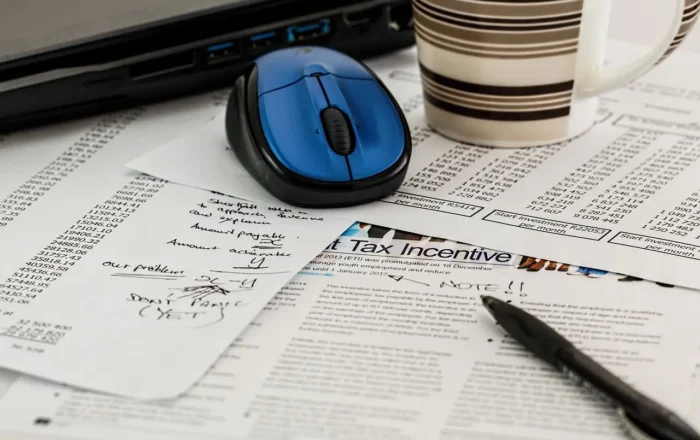Does Texas Have State Income Tax? Overview of Texas Taxes
4 minute readLearn how Texas’s unique tax structure—without state income tax but with higher property and sales taxes—impacts residents, renters, and businesses in 2025.
Home > Blog > What Is the Average kWh Usage in Texas?
The average Texas household consumes about 1,146 kWh monthly.
6 minute read • Last update March 2025

Everything’s bigger in Texas, and that includes its energy consumption. This means that average electricity bills for Texans remain consistently higher than the national average. But what drives this elevated consumption? Is it the sweltering summers that demand round-the-clock air conditioning? And more importantly, how can residents mitigate these costs and reduce their (kilowatt-hour) kWh usage?
In this article, we’ll dissect the intricacies of Texas’s energy consumption. We’ll explore the factors that contribute to its higher-than-average kWh usage and offer actionable strategies for Texans to harness their energy consumption more efficiently. By understanding the dynamics at play, Texans can not only reduce their monthly bills but also contribute to a more sustainable energy future for the Lone Star State.
A kilowatt-hour (kWh) is a standard unit of measurement that represents the amount of energy consumed over a period of time. Think of it like this: if you have a 1 kW (1,000-watt) appliance running for one hour, it would consume one kilowatt-hour (1 kWh) of energy. This unit is crucial because your electric bill is essentially a tally of the total kWh used in your household during a billing cycle. The more kWh you consume, the higher your energy costs.
According to the U.S. Energy Information Administration, the average monthly electricity consumption for Texas household is 1,146 kWh. This means the average Texan household requires around 36 kWh of energy every day. This is noticeably higher than the national figure of 855 kWh per month or 28.5 kWh per day. Let’s explore this discrepancy a bit further.
Extreme weather events, such as cold snaps, droughts, and heatwaves, significantly impact monthly average kilowatt-hour (kWh) consumption. During periods of intense temperature fluctuations, households and businesses increase their use of heating and cooling systems, leading to higher overall energy demand. Severe weather can also strain power infrastructure, causing outages that disrupt energy supply and further influence consumption patterns. Following the failures during Winter Storm Uri in February 2021—largely due to insufficient grid winterization—Texas implemented Senate Bill 3 (SB3) to strengthen grid resilience. However, while some improvements have been made, ongoing vulnerabilities continue to affect energy stability, underscoring the link between extreme weather and fluctuating monthly kWh usage.

In Texas, two things primarily affect how much electricity we use: our big homes and our hot weather. Most Texas homes are pretty roomy, with many over 2,000 square feet. Bigger spaces mean more air to heat or cool. And let’s face it, we lean on our air conditioners a lot especially during our long summers. All of this adds up, and it’s why our electric bills can be higher than the average American household.
In addition to air conditioners, other appliances use up energy throughout the year. While this data isn’t regionalized, the U.S. Energy Information Administration provides approximate percentages that offer insight into how your electricity is being consumed. Below is a % breadown of which categories of appliances consume energy in our homes:
In Texas, the average household consumes about 1,194 kWh of electricity each month, and with the median house size being approximately 2,170 square feet, this translates to about 0.504 kWh per square foot per month.
If you’re trying to estimate your monthly kWh usage based on square footage, you can multiply your home’s total square footage by 0.504 (or divide by 2 for a rough estimate). For instance, a 1,000 square foot apartment would have an estimated usage of 504 kWh monthly.
However, it’s important to remember that this is a general estimate. Many factors can impact your actual kWh usage, such as the efficiency of your appliances, utilization of smart home devices, the insulation of your home, and your personal habits. So, while square footage can give you a ballpark figure, always consider other variables that might increase or decrease your energy consumption.
Electricity costs in Texas vary significantly by city, driven largely by climate conditions and consumption patterns. Houston, burdened by intense heat and high humidity, leads in residential energy usage and associated costs. Meanwhile, cities like Dallas and Austin see lower or more variable electricity bills due to differing weather patterns and rate structures. Analyzing ERCOT and regional pricing data, the disparity in monthly electricity expenses across Houston, Dallas, and Austin reveals key insights into how geography and utility rates impact household budgets.
| City | Average monthly kWh usage | Average energy rate | Average monthly electric bill |
|---|---|---|---|
| Houston | 1,300 kWh | 18.55 cents per kWh | $241.15 |
| Austin | 1,530 kWh | 14.00 cents per kWh | $219.00 |
| Dallas | 937 kWh | 18.55 cents per kWh | $173.81 |
Energy consumption in Texas is greatly affected by its weather conditions. Particularly, summer cooling needs and winter heating requirements can have an impact on energy usage. Extreme weather events like droughts will also affect how much electricity Texans consume each year.

Texans rely heavily on air conditioning during the sweltering summer months, and this upsurge in electricity usage leads to elevated energy bills. Extreme weather events such as heatwaves can boost consumption significantly—and put additional strain on the state’s power grid.
For example, during the sweltering summer months in Austin, residential customers use significantly more electricity, often surpassing 1,200 kWh in a month, compared to the milder winter months where usage can drop to around 700 kWh. This variation is primarily due to the increased reliance on air conditioning systems to combat the Texas heat.
While we may have milder winters in Texas (most of the time), households can still have significant energy requirements. The occasional cold snaps, coupled with the desire for consistent indoor comfort, mean that many Texans rely on heating systems to maintain a cozy environment. This need for warmth, even during a milder winter, can lead to a noticeable uptick in kWh usage. It’s a testament to the fact that even in the face of our “gentler” winters, the energy demands of a Texas household remain ever-present.
In Texas, extreme weather such as cold snaps, droughts, and heatwaves have an obvious effect on energy consumption. During these episodes of significantly varying temperature, people need to use their heating or cooling systems more frequently, which results in a higher demand for energy usage overall. Strong climate phenomena can cause damage to the power infrastructure leading to momentary outages in some regions with resultant gaps in the continuous supply of electricity.
BKV Energy has many tips to help you bring down electricity bills and reduce energy consumption in Texas. The installation of efficient appliances, a smart thermostat, and regular maintenance as well as insulation will help decrease the kWh usage. By utilizing these methods, Texans can curb overall energy usage and save money on their monthly energy bills at the same time.

Texans can save on their electricity bills and minimize the amount of energy they consume by using appliances that are certified as being more efficient. These products, which typically have an Energy Star label attached to them, require less power than standard home machines resulting in lower energy expenses.
By investing in a smart thermostat and temperature control system, Texans can save on their electricity bills and reduce the amount of energy they use. This technology allows users to set their desired temperatures when they’re away or present with great precision for optimal energy efficiency.
These systems also help homeowners keep an eye on how much power is being used so that measures can be taken to Lower costs whilst keeping comfort levels as high as possible. The benefits extend beyond just cost savings. By lowering their carbon footprint through efficient electricity usage, Texan residents will make positive contributions toward sustainability.
In Texas, consistent home maintenance and effective insulation play pivotal roles in curbing energy consumption. Proper insulation acts as a barrier, preventing external heat from infiltrating, allowing air conditioning systems to operate with greater efficiency and reduced energy demands. Regularly servicing and maintaining cooling appliances not only extends their lifespan but also ensures they run at peak performance, contributing to overall energy conservation.
At BKV Energy, we understand the unique energy needs of Texas residents. We know that the sweltering summers and surprisingly chilly winters can lead to high energy consumption, and we’re here to help you navigate these challenges.
No matter what your energy usage or needs are, BKV Energy is here to provide simple and straightforward plans plans tailored to your unique requirements. We understand that every Texan household has its own energy consumption patterns, and we’re committed to offering solutions that align with your lifestyle and budget.
Graham Lumley, Digital Marketing Manager at BKV Energy, leads digital and traditional marketing strategies, focusing on educating Texans about the state's deregulated energy market. With over 8 years of marketing experience, he creates content to help consumers understand and save on their energy bills, bringing a fresh and dynamic approach to the industry.

Learn how Texas’s unique tax structure—without state income tax but with higher property and sales taxes—impacts residents, renters, and businesses in 2025.

Learn how to navigate Texas’s diverse job market based on your role, location, and job search strategy.
Get $50 off your electric bill!
Use code BKVEJOINUS50
Enter your zip code to shop BKV Energy's affordable, fixed-rate Texas electricity plans. Use the promo code for $50 off your electric bill.